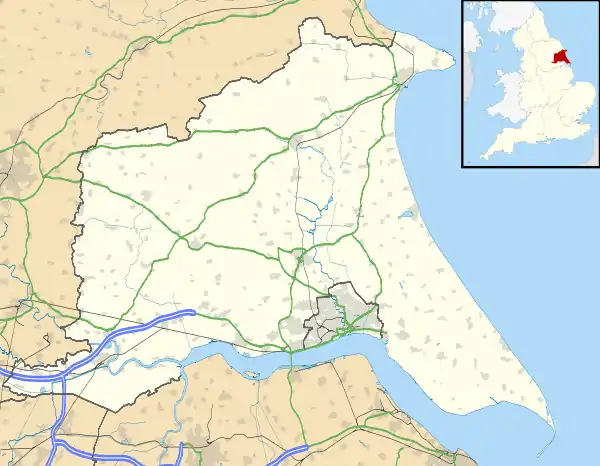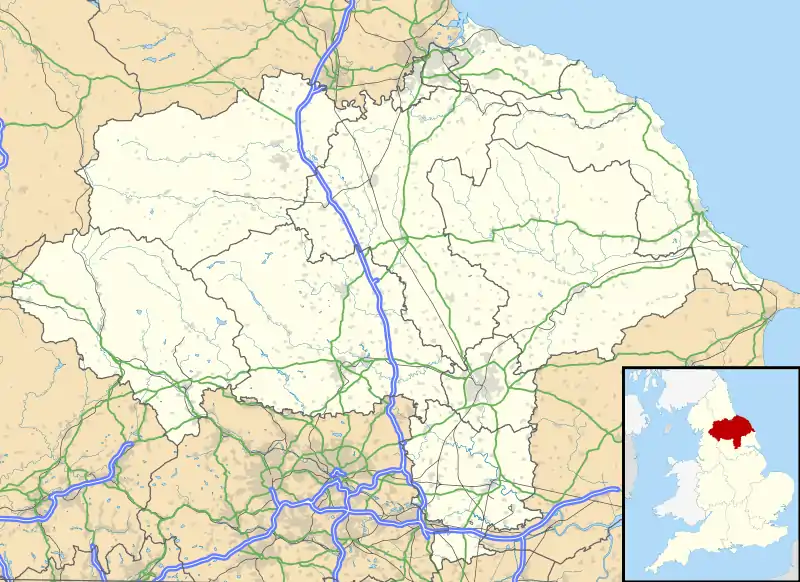Football in Yorkshire
Football in Yorkshire refers to the sport of association football in relation to its participation and history within Yorkshire, England. The county is the largest in the United Kingdom and as thus has many football clubs professional and amateur.

Sheffield in South Yorkshire is recognised by FIFA and UEFA as the birthplace of club football, because Sheffield F.C. are the oldest association football club in the world.[1] Hallam F.C. also from Sheffield are the second oldest. With its origins in the Sheffield Rules code, the game eventually spread to other parts of the county after Hull local Ebenezer Cobb Morley wrote The Football Association's Laws of the Game, which are still used worldwide today.
History as footballing innovators
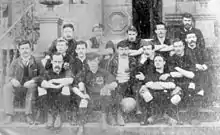
The county has a very long tradition in the sport; it is officially recognised by FIFA as being the birthplace of club football as the world's oldest club Sheffield F.C. was formed in Sheffield during 1857.[1] Two men from Sheffield codified a set of rules for the game in 1857, these were known as the Sheffield rules and the Football Association rules which were created in 1863 were based in part on them. Ebenezer Cobb Morley was the first secretary of The Football Association, its second ever president and the man who drafted the FA's laws of the game at his home in Hull.
The world's first ever inter-club match took place on 26 December 1860 in Sheffield; the match was between Sheffield F.C. and a newly formed club named Hallam F.C.; Sheffield won 2–0. As Hallam were also from the city of Sheffield, this would also prove to be the world's first ever local derby in club football. Notably, Hallam's home ground Sandygate Road, at which they still play at today, was first opened in 1804 and is recognised by the Guinness Book of Records as the oldest ground in the world.[2]
1860s to 1920s
- Herbert Chapman — played for many teams, but was most noted as a manager for Huddersfield Town and Arsenal winning the top honours in English football. He is credited with being one of the game's first modernisers, introducing new tactics and training regime; Chapman is also credited with the introduction of shirt numbers in the sport.[3]
- Thomas Hogg and Chris Hogg — brothers from Skelton, Yorkshire introduced football to Argentina, they organised a meeting on 9 May 1867 where the oldest football club in Argentina was founded in the form of Buenos Aires Football Club.[4]
- Joseph Whitaker — one of the key figures in the foundation of US Palermo, the second oldest football club in Sicily. His family were wealthy 19th-century tycoons from West Yorkshire,[5] who moved to develop a wine industry in Sicily.
- Frank Womack — played for Birmingham City, he holds the all-time league appearances record for the club, turning out a total of 491 times.[6]
1930s to 1970s
- Gordon Banks — from Sheffield, played club football largely at Leicester City and Stoke City. With England, he was part of the 1966 FIFA World Cup winning squad, he represented the country 73 times. Banks was elected in a poll by the IFFHS as the second best goalkeeper of the 20th century.[7] He is also acknowledged by FIFA to have made one of the finest saves in the history of the World Cup, at the 1970 tournament, against Pelé of Brazil.[8] He has been awarded an OBE for his contributions to sport.
- George Raynor — from Barnsley, transformed the Swedish national team into a powerful force in the late 1940s, and 1950s. He guided them to an Olympic gold in 1948 and a bronze medal in 1952. In the 1950 World Cup he guided them to 3rd place behind only Brazil and Uruguay, and in 1958 he led them to the final, losing again to Brazil. His remarkable achievements went largely unnoticed and unrecognised in his native England, although in continental Europe he enjoyed short spells as manager of clubs such as Lazio and Juventus.
- Bill Nicholson — from Scarborough, he guided Tottenham Hotspur to the double, the first club to do so in the 20th century. Under his management they also became the first English club to win a European trophy, the European Cup Winners Cup in 1963.
- Don Revie — from Middlesbrough, he had an influential career as both a player and manager. As a player, he became famous as one of the first deep-lying centre forwards of the English game in Manchester City's so-called Revie Plan. In management he transformed Leeds United from Second Division also-rans into one of the most feared club sides in Europe, in the late 1960s and early 1970s. His remarkable achievements with the club were recognised with three Manager of the Year awards, an OBE and the England manager's job, which he eventually left controversially to take up a role in the Middle East.
- Brian Clough — from Middlesbrough, he transformed Derby County from a struggling Second Division club, into first division title winners in 1971–72 Football League First Division, also reaching the European Cup semi-final under his guidance. He was successful again with another struggling Second Division club, Nottingham Forest, winning the first division title in 1978 and the European Cup successively in 1979, and 1980
Football clubs in Yorkshire
The table below lists clubs located within the traditional borders of Yorkshire in the top eight tiers of the English football league system: from the top division (the Premier League), down to Step 4 of the National League System.
| Club | Stadium | Capacity | Founded | County Subdivision | Notes | ||||||
|---|---|---|---|---|---|---|---|---|---|---|---|
| Premier League (1) | |||||||||||
| Leeds United | Elland Road | 37,697 | 1919 | West Yorkshire | League Champions 1968–69, 1973–74, 1991–92 FA Cup Winners 1971–72 League Cup Winners 1967–68 FA Charity Shield Winners 1969, 1992 UEFA Cup Winners 1967–68, 1970–71 | ||||||
| Sheffield United | Bramall Lane | 32,702 | 1889 | South Yorkshire | League Champions 1897–98 FA Cup Winners 1888–89, 1901–02, 1914–15, 1924–25 | ||||||
| Football League Championship (2) | |||||||||||
| Barnsley | Oakwell | 23,009 | 1887 | South Yorkshire | FA Cup Winners 1911–12 | ||||||
| Huddersfield Town | John Smith's Stadium | 24,500 | 1908 | West Yorkshire | League Champions 1923–24,1924–25, 1925–26 FA Cup Winners 1921–22 FA Charity Shield Winners 1922 | ||||||
| Middlesbrough | Riverside Stadium | 34,988 | 1876 | North Yorkshire | League Cup Winners 2003–04 UEFA Cup Runners-up 2005–06 FA Amateur Cup Winners 1894–95, 1897–98 | ||||||
| Rotherham United | New York Stadium | 12,021 | 1925 | South Yorkshire | Football League Third Division (North) Champions 1950–51 Football League Third Division Champions 1980–81 Football League Trophy Winners 1995–96 Football League Third Division North Cup 1945–46 | ||||||
| Sheffield Wednesday | Hillsborough Stadium | 39,812 | 1867 | South Yorkshire | League Champions 1902–03, 1903–04, 1928–29, 1929–30 FA Cup Winners 1895–96, 1906–07, 1934–35 League Cup Winners 1990–91 FA Charity Shield Winners 1935 | ||||||
| Football League One (3) | |||||||||||
| Doncaster Rovers | Keepmoat Stadium | 15,231 | 1879 | South Yorkshire | Football League One Champions 2012–13 Football League Third Division (as fourth tier) Champions 2003–04 Football League Fourth Division Champions 1965–66, 1968–69 Football League Trophy Winners 2006–07 Conference League Cup Winners 1998–99, 1999–2000 | ||||||
| Hull City | KC Stadium | 25,586 | 1904 | East Riding of Yorkshire | FA Cup Runners-up 2013–14 Football League Championship Runners-up 2012–13 Football League Third Division Winners 1965–66 Football League Third Division (North) Winners 1932–33, 1948–49 | ||||||
| Football League Two (4) | |||||||||||
| Bradford City | Valley Parade | 25,136 | 1903 | West Yorkshire | FA Cup Winners 1910–11 | ||||||
| Harrogate Town | Wetherby Road | 5,000 | 1914 | North Yorkshire | |||||||
| National League (5) | |||||||||||
| F.C. Halifax Town | The Shay | 14,061 | 2008 | West Yorkshire | Club reformed following the demise of Halifax Town A.F.C. (HTAFC – Conference National Champions 1997–1998) FA Trophy Winners 2015–16 | ||||||
| National League North (6) | |||||||||||
| Bradford Park Avenue | Horsfall Stadium | 3,500 | 1907 | West Yorkshire | Football League Third Division (North) Champions 1927–28 | ||||||
| Guiseley | Nethermoor Park | 3,000 | 1909 | West Yorkshire | FA Vase Winners 1990–91 | ||||||
| York City | Bootham Crescent | 8,256 | 1922 | North Yorkshire | FA Trophy Winners 2011–12, 2016–17 Football League Fourth Division Champions 1983–84 |
Farsley Celtic | Throstle Nest | 3,900 | 1908 | West Yorkshire | |
| Northern Premier League Premier Division (7) | |||||||||||
| Scarborough Athletic | Flamingo Land Stadium | 2,833 | 2007 | North Yorkshire | Phoenix club formed after closure of Scarborough F.C. ( S.F.C. – Conference National Champions 1986–1987) (FA Trophy Winners 1972–73,1975–76 & 1976–77) | ||||||
| Whitby Town | Turnbull Ground | 3,500 | 1880 | North Yorkshire | FA Vase Winners 1996–97 | ||||||
| Northern Premier League Division One North (8) | |||||||||||
| Brighouse Town | St Giles Road | 1,000 | 1963 | West Yorkshire | |||||||
| Ossett United | Ingfield | 2,000 | 2018 | West Yorkshire |
Ossett Town (formed 1936) and Ossett Albion (formed 1944) merged in 2018 | ||||||
| Tadcaster Albion | i2i Stadium | 2,000 | 1892 | North Yorkshire | |||||||
| Northern Premier League Division One South (8) | |||||||||||
| Frickley Athletic | Westfield Lane | 2,087 | 1910 | West Yorkshire | |||||||
| Sheffield F.C. | Coach & Horses Ground, Dronfield | 2,000 | 1857 | South Yorkshire | Oldest Active Football Club in the World | ||||||
| Stocksbridge Park Steels | Look Local Stadium, Bracken Moor | 3,500 | 1986 | South Yorkshire | |||||||
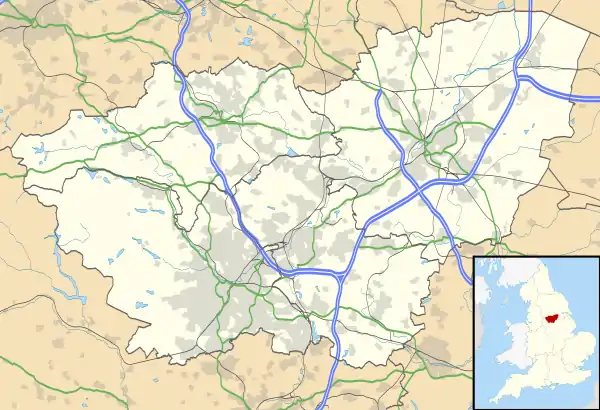
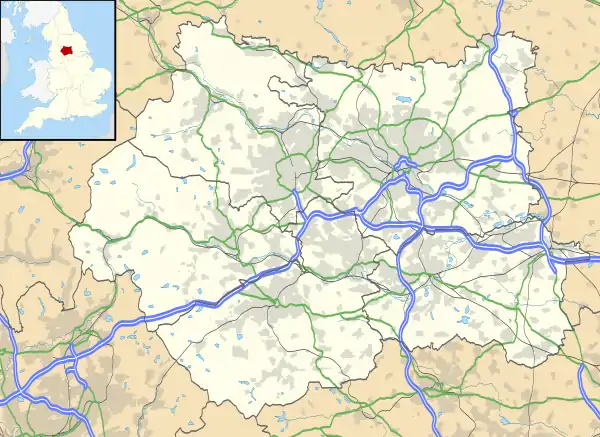
See also
Notes
- TheFA.com. "World's Oldest Football Club". Archived from the original on 29 October 2007. Retrieved 27 June 2007.
- Rob Power (September 2003). "The Ultimate A-Z of Sheffield". bbc.co.uk. Archived from the original on 20 February 2007. Retrieved 8 February 2008.
- Guardian.co.uk
- Gorgazzi, Osvaldo José; Bobrowsky, Josef (18 February 1999). "Some Information on the Early History of Football in Argentina". RSSSF. Retrieved 8 January 2008.
- Whitaker Family
- Birmingham City records at Soccerbase
- IFFHS' Century Elections Archived 3 March 2009 at the Wayback Machine – rsssf.com – by Karel Stokkermans, RSSSF.
- World Cup 1970 Photo Gallery – fifaworldcup.yahoo.com – FIFA.
